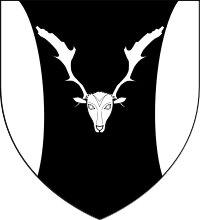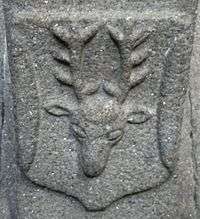Earl of Morley

Earl of Morley, of Morley in the County of Devon, is a title in the Peerage of the United Kingdom. It was created in 1815 for John Parker, 2nd Baron Boringdon. He was made at the same time Viscount Boringdon, of North Molton in the County of Devon, which title is used as a courtesy title by the heir apparent to the earldom.
Appellation of Morley
There existed between 1299 and 1697 an ancient Barony of Morley first held by the de Morley family, lords of the manor of Morley Saint Botolph in Norfolk, which passed in 1489 by marriage to the Parker family, apparently unrelated to the Parker family of Saltram, Devon which latter had emerged in the 16th century from seemingly humble origins in North Molton in Devon. It can thus be no co-incidence that in 1815 John Parker, 2nd Baron Boringdon (1772–1840), on his elevation to the dignity of an earl in 1815, chose the title Earl of Morley, ostensibly referring to his recent purchase of the relatively minor Devon manor of Morley[3] (modern spelling Morleigh), midway between Totnes and Kingsbridge. It had become common in the 19th century for members of the post-mediaeval nobility when elevated further in the peerage to adopt defunct mediaeval titles which bore some ostensible link to the family, thus lending it an air of great antiquity. Such actions were often adopted in all innocence based on erroneous pedigrees produced by genealogists overly eager to please their patrons.[4] An example is the Russell family, Dukes of Bedford, of which a younger son when himself elevated to the peerage adopted the title "Baron Russell of Kingston Russell", an ancient Dorset manor with which his family had in fact no historic connection.[5]
Baron Boringdon

The title of Baron Boringdon, of Boringdon in the County of Devon, was created in the Peerage of Great Britain in 1784 for his father John Parker, who had previously represented Bodmin and Devon in the House of Commons.
Lord Morley was succeeded by his only son, the second Earl. He held minor office in the first Whig administration of Lord John Russell. His son, the third Earl, was a Liberal politician and notably served under William Ewart Gladstone as Under-Secretary of State for War and as First Commissioner of Works. His grandson, the sixth Earl, succeeded his uncle in 1962 (who in his turn had succeeded his elder brother in 1951). He was the eldest son of the Hon. John Holford Parker, third and youngest son of the third Earl. Lord Morley served as Lord Lieutenant of Devon from 1982 to 1998. He was succeeded by his only son in 2015
The family seat was Saltram House in Plymouth. It was sold to the National Trust in 1957 and remained the family seat until the fifth Earl died in 1962. Their seat is now Pound House, near Yelverton, Devon.
Barons Boringdon (1784)
- John Parker, 1st Baron Boringdon (d. 1788)
- John Parker, 2nd Baron Boringdon (1772–1840) (created Earl of Morley in 1815)
Earls of Morley (1815)
- John Parker, 1st Earl of Morley (1772–1840)
- Edmund Parker, 2nd Earl of Morley (1810–1864)
- Albert Edmund Parker, 3rd Earl of Morley (1843–1905)
- Edmund Robert Parker, 4th Earl of Morley (1877–1951)
- Montagu Brownlow Parker, 5th Earl of Morley (1878–1962)
- John St Aubyn Parker, 6th Earl of Morley (1923–2015)
- Mark Lionel Parker, 7th Earl of Morley (b. 1956)
The heir presumptive is the present holder's uncle the Hon. Nigel Parker (b. 1931).
The heir presumptive's heir is his son Edward Geoffrey Parker (b. 1967)
Notes
- ↑ A stag's head is shown as the arms of the family on the 1609 wooden screen from Court House, North Molton, now in North Molton Church, but the 18th-century arms used by the family, much in evidence at Saltram, show a buck's head
- ↑ Buck's head per Debrett's Peerage, 1968, Earl of Morley, p.795
- ↑ 1810 Additions to Tristram Risdon's "Survey of Devon", p.386: "The manor of Morley did belong to John Shapleigh, Esq., who sold it to John Seale, of Mount Boon, Esq., from whom it was purchased by Lord Boringdon, the present proprietor"
- ↑ e.g. Wiffen, the librarian at Woburn of the Duke of Bedford, who produced a pedigree of the Russells containing a fabricated link to the mediaeval Russell family of Kingston Russell
- ↑ Scott-Thomson, Gladys,F.R.H.S. Two Centuries of Family History, London, 1930. (A study of the Bedford Russell early pedigree). Several similar mis-appropriations of lineages of ancient families are given in this work.
- ↑ Burke's General Armory, 1884
Bibliography
- Cokayne, George E; Gibbs, Vicary; Doubleday, Harry A. (1953). The Complete Peerage of the Peerage and Baronetage in Great Britain and Ireland including abeyant, dormant and extinct titles. XIV volumes. St Catherine's Press.
- Mosley, Charles (1999). Burke's Peerage and Baronetage (106th ed.). Burke's Genealogical Publishing Co.
- Mosley, Charles (2003). Burke's Peerage and Baronetage (107th ed.).
- Kidd, Charles; Williamson, David (1990). Debrett's Peerage and Baronetage. New York: St Martin's Press.
- http://www.leighrayment.com
- Lundy, Darryl. "John, 7th Earl of Morley".
- "David Beamish's Peerage Page".
